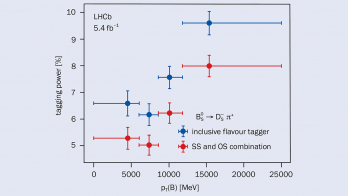Muon neutrinos definitely disappear en route from Fermilab in Illinois to Soudan in Minnesota. This is the conclusion from the first results of the Main Injector Neutrino Oscillation Search (MINOS), presented at a seminar at Fermilab on 30 March, which showed that MINOS has observed the disappearance of a significant fraction of these neutrinos. The observation is consistent with the phenomenon of neutrino oscillation, in which neutrinos change from one kind to another, and corroborates earlier observations of muon-neutrino disappearance, made by the Super-Kamiokande and KEK-to-Kamioka (K2K) experiments in Japan.

The Fermilab side of the MINOS experiment comprises a beam-line in a 1220 m long tunnel pointing towards Soudan. The tunnel holds the carbon target and beam-focusing elements that generate neutrinos from protons accelerated by Fermilab’s Main Injector accelerator. A neutrino detector, the MINOS “near detector” located 100 m underground on the Fermilab site, measures the composition and intensity of the neutrino beam as it leaves the laboratory. The Soudan side of the experiment features the 6000 tonne “far” detector about 700 m underground, which measures the properties of the neutrinos after their 725 km trip to northern Minnesota.
If neutrinos did not change as they travel away from Fermilab, the MINOS detector in Soudan should have recorded 177±11 muon neutrinos. Instead, the collaboration found only 92 muon-neutrino events – a clear observation of muon-neutrino disappearance. The deficit as a function of energy is consistent with the hypothesis of neutrino oscillations, which can occur only if different neutrino types have different masses. The MINOS observations yield a value of Δm2, the square of the mass difference between two types of neutrinos, equal to 0.0031 ±0.0006 (statistical uncertainty) ±0.0001 (systematic uncertainty) eV2.
In the oscillation scenario, muon neutrinos can transform into electron neutrinos or tau neutrinos, but alternative models – such as neutrino decay and extra dimensions – are not yet excluded. The MINOS collaboration will need to record much more data to test more precisely the exact nature of the disappearance process. Over the next few years, the experiment should collect about fifteen times more data, yielding more results with higher precision.
The MINOS neutrino experiment follows on from the K2K long-baseline neutrino experiment in Japan. From 1999-2001 and 2003-2004, K2K sent neutrinos created at an accelerator at the KEK laboratory to a detector in Kamioka, a distance of about 240 km. Compared with K2K, the distance in the MINOS experiment is three times longer, and both the intensity and the energy of the MINOS neutrino beam are higher. These advantages have enabled the MINOS experiment to observe in less than a year about three times as many neutrinos as K2K did in around four years. Later this year the CERN Neutrinos to Gran Sasso project will start delivering muon neutrinos to the Gran Sasso National Laboratory in Italy.
• The MINOS experiment includes about 150 scientists, engineers, technical specialists and students from 32 institutions in six countries, including Brazil, France, Greece, Russia, the UK and the US. The US Department of Energy provides the major share of the funding, with additional funding from the US National Science Foundation and the UK’s Particle Physics and Astronomy Research Council. For more information on the experiment see www-numi.fnal.gov/.







